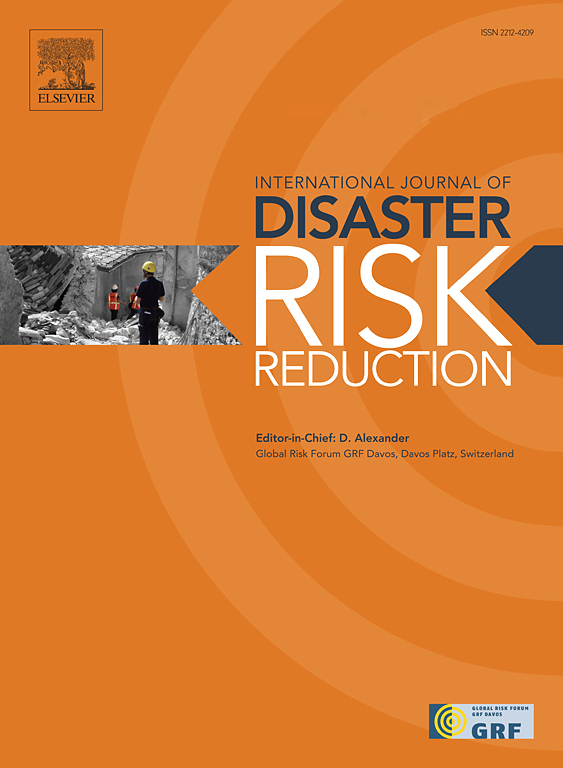A multiscale physically-based approach to urban flood risk assessment using ABM and multi-source remote sensing data
IF 4.2
1区 地球科学
Q1 GEOSCIENCES, MULTIDISCIPLINARY
International journal of disaster risk reduction
Pub Date : 2025-02-21
DOI:10.1016/j.ijdrr.2025.105332
引用次数: 0
Abstract
In recent years, global climate change and rapid urban development have led to frequent urban pluvial flooding disasters, severely threatening urban safety and the lives and property of residents. Urban pluvial flooding involves both natural and social factors. Its risk is influenced not only by natural factors such as rainfall intensity and terrain but also closely related to human factors like population distribution and socio-economic development. However, existing risk assessment methods often overemphasize natural disaster factors while failing to adequately consider the dynamic response characteristics of social systems. These methods typically rely on static indicators and simplify the study area into homogeneous spaces, overlooking the differences in drainage systems and surface characteristics between regions. Therefore, incorporating the dynamic characteristics of population vulnerability into the risk assessment framework and developing models that reflect the coupling of natural and social systems are essential for accurately describing the evolution of urban pluvial flood risk and enhancing disaster prevention strategies. This study takes the main urban area of Jincheng City, Shanxi Province, as an example. Based on spatial heterogeneity, the area is divided into regions with dense and sparse drainage networks. A hydrological-hydrodynamic coupled model is constructed to reveal the physical mechanisms of flood evolution in different areas. Additionally, an agent-based model (ABM) is used to simulate population evacuation behaviors and changes in risk states during flooding. Through sensitivity analysis of the key parameters in the ABM, the main factors influencing the dynamic changes in population vulnerability are identified, providing scientific support for optimizing emergency decision-making. Combining multi-source remote sensing data with the cloud model approach, a comprehensive dynamic flood risk assessment framework is established. This framework not only reflects the spatial differentiation characteristics of flood risk in different regions but also quantitatively describes the temporal evolution of risks, offering a new analytical perspective for urban flood prevention and disaster mitigation. The study results show that spatial heterogeneity within the city leads to significant differences in the carrying capacity of drainage systems, with 85.59 % of the drainage network already operating beyond capacity under a low return period (1-year return period). Population exposure exhibits obvious spatiotemporal dynamic characteristics, with the proportion of population risk under different return periods (1∼100-year return period) fluctuating between 15.04 % and 22.64 %, mainly concentrated at critical nodes such as road intersections. The regional flood risk level shows an evolution trend from low to high over time, and the depth of water sensation (correlation coefficient: 0.849) is identified as a key factor affecting population safety levels. This methodological framework not only provides support for refined urban flood prevention and disaster mitigation planning and emergency management, but also holds significant practical value for enhancing urban resilience and disaster prevention capabilities.

求助全文
约1分钟内获得全文
求助全文
来源期刊

International journal of disaster risk reduction
GEOSCIENCES, MULTIDISCIPLINARYMETEOROLOGY-METEOROLOGY & ATMOSPHERIC SCIENCES
CiteScore
8.70
自引率
18.00%
发文量
688
审稿时长
79 days
期刊介绍:
The International Journal of Disaster Risk Reduction (IJDRR) is the journal for researchers, policymakers and practitioners across diverse disciplines: earth sciences and their implications; environmental sciences; engineering; urban studies; geography; and the social sciences. IJDRR publishes fundamental and applied research, critical reviews, policy papers and case studies with a particular focus on multi-disciplinary research that aims to reduce the impact of natural, technological, social and intentional disasters. IJDRR stimulates exchange of ideas and knowledge transfer on disaster research, mitigation, adaptation, prevention and risk reduction at all geographical scales: local, national and international.
Key topics:-
-multifaceted disaster and cascading disasters
-the development of disaster risk reduction strategies and techniques
-discussion and development of effective warning and educational systems for risk management at all levels
-disasters associated with climate change
-vulnerability analysis and vulnerability trends
-emerging risks
-resilience against disasters.
The journal particularly encourages papers that approach risk from a multi-disciplinary perspective.
 求助内容:
求助内容: 应助结果提醒方式:
应助结果提醒方式:


